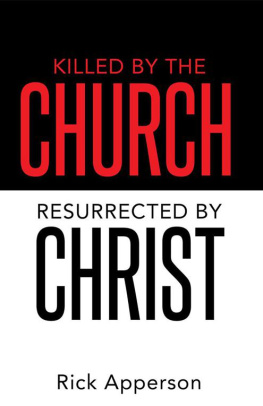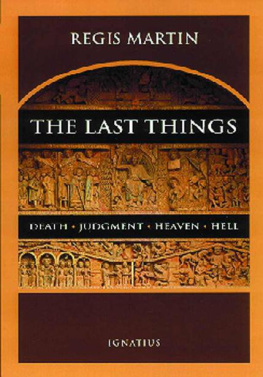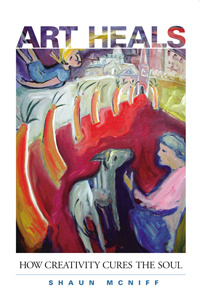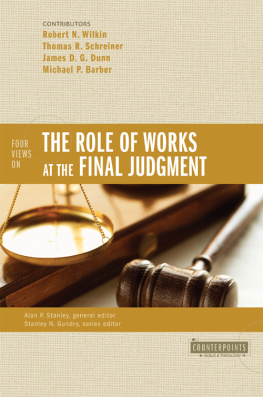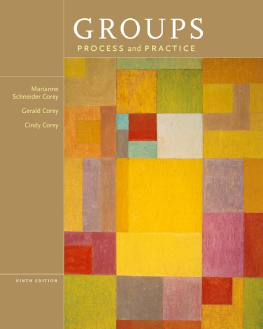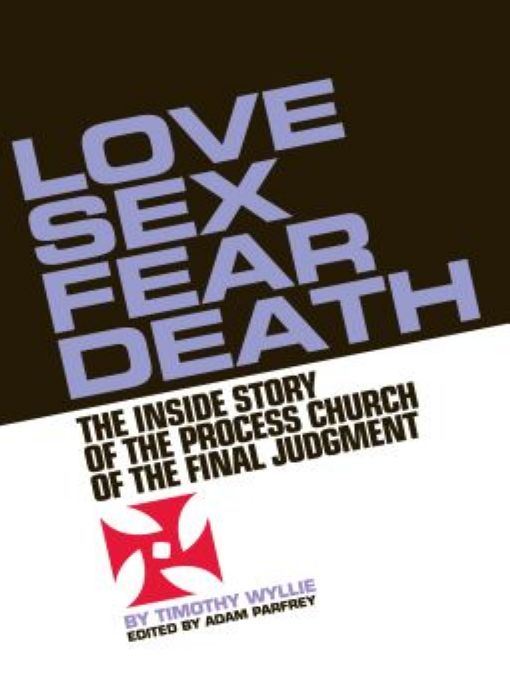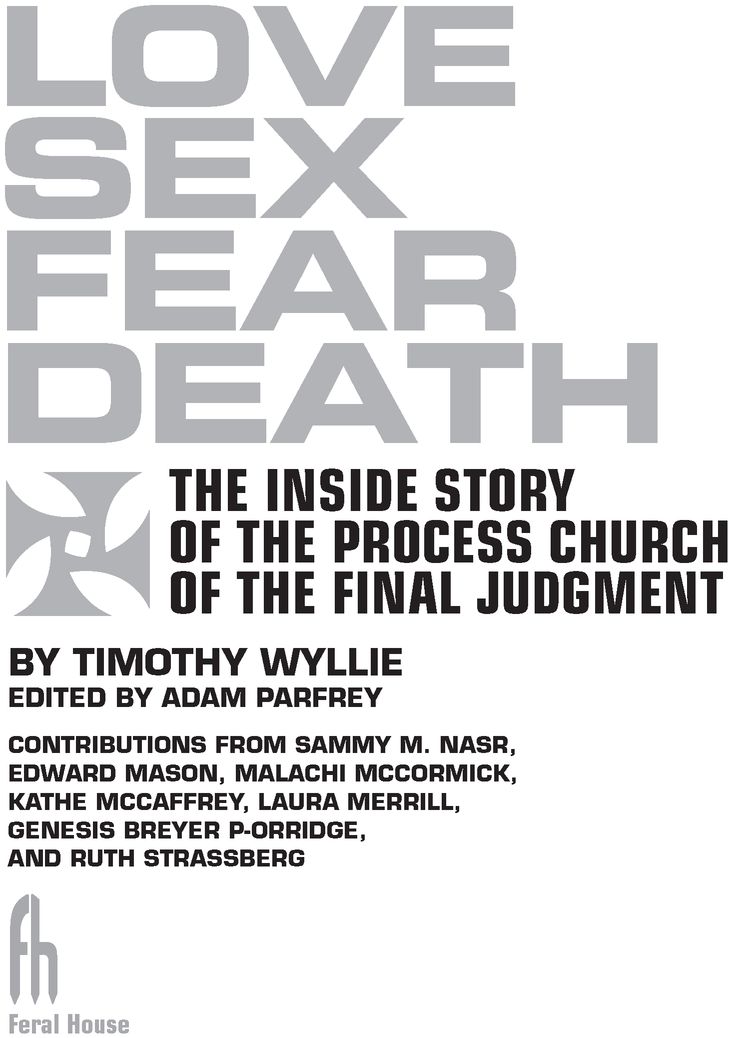Table of Contents
RARELY WHAT IT SEEMS
Adam Parfrey
Though a product of the 60s, The Process Church disdained flower power, tie-dye and patchouli oil. On the street they wore black cloaks with hoods and Goat of Mendes patches, selling literature with titles like Death and Fear and Humanity is the Devil.
The Process Church of the Final Judgment officially changed its name and its Gods in 1975, but even today the original group enjoys cultural influence. Its screeds were reproduced as liner notes for two Funkadelic albums; Skinny Puppy had an album called Process complete with anti-vivisection lyrics, a prominent Process Church concern. Process rituals were appropriated and valorized by Psychick TV and Thee Temple Ov Psychick Youth (or TOPY), and The Process misanthropic bombast appeared on the pages of my Apocalypse Culture compilation.
The apocalyptic group also inspired sinister conspiracy theories and was called, by Maury Terrys The Ultimate Evil, one of the most dangerous satanic cults in America.
Their story begins in London in 1963, when the United States was playing Cold War chicken with the Soviet Union, and children ducked and covered in classrooms. Less than 20 years earlier, Germany rained V2 bombs on Londoners heads, and for citizens alert to the Cuban Missile Crisis, mass nuclear death not only seemed possible, but inevitable.
The psychological havoc of nuclear end times preoccupied two Church of Scientology members who grumbled that its teachings were turning people into little L. Ron Hubbards. One of the dropouts, Robert Moor, was a married architecture student, and the other, Mary Ann MacLean, was an aggressive and charismatic woman who had bootstrapped herself out of a poor background as a call girl.
Robert and Mary Ann hijacked a Scientology E-meter and struck out on their own with a group called Compulsions Analysis, combining Scientology auditing techniques with Alfred Adler-style psychotherapy to dig deeper into the dynamics of self-actualization.
Under Mary Anns urging, Robert broke up his marriage, changed his last name to de Grimston, and brought in his architecture school friend Timothy Wyllie as a guinea pig for E-meter (later renamed P-scope) tests after the Process Church found its name.
Timothy found these procedures helpful in breaking through British stiff-upper-lip stoicism to connect with his deeper self. Mixed feelings toward Mary Ann provoked Timothy to drop out of Compulsions Analysis, but two years later he returned to the fold, becoming convinced that Mary Ann was his true spiritual guide. These moments, and Process transition from atheism into occult practices are compellingly told by Timothy Wyllie in this book.
We have photographs to prove that dark-cloaked Process Church Messengers went out into the world wearing crucifixes and Luciferian sigils. Such was the look of a group of committed young people who saw the world coming to an end, but to their disbelief, few seemed to be paying any mind.
Love Sex Fear Death began as a collaborative effort with Genesis P-Orridge to publish a monograph of Process magazines. The monograph concept was bypassed after speaking to Timothy Wyllie and other former Process memberstheir previously unrevealed memories excited us more as a book than simply reproducing the colorful magazines alone. Timothy was a longtime and prominent member of The Process Church and its later incarnations, The Foundation Church of the Millennium and then The Foundation Faith of the Millennium. He art-directed Fear and Death and other notorious Process publications, and even played lead guitar for Process own rock band. Our lengthy conversations sparked Timothys enthusiasm for presenting his story in written form.
Timothy surprised me when he revealed that a number of inside elements did not correspond with Process public image. For the first time, I discovered that The Process Church was in fact a matriarchal cult ruled by co-founder Mary Ann, who was treated as a goddess by most of its members. Apparently the biggest issue in the groups schism with Robert was simply finding another public face for leadership. Mary Ann never wanted to be the official leader, and her image became forbidden inside Process and Foundation Faith Chapters. Were lucky to have one photograph of Mary Ann in the form of a flash-marred snapshot of another photograph.
This book is supplemented with original photos collected by Sammy M. Nasr, who fortunately disobeyed Mary Anns directive to destroy the images. We were also able to speak at length with Malachi (Father Malachi) McCormick, a longtime high-level Process Church leader who edited many of the Process magazines and newsletters. We communicated with other former members, some of whom provided us their fascinating memories, and others who declined to participate. This book breaks through decades of silence, and tells the story from the vantage points of half a dozen former members.
Approximately a dozen people from the original Process collective continue to work together today within the large and successful animal sanctuary known as Best Friends. We have not solicited anecdotes from ex-Process members within Best Friends. After a 2/28/04 Rocky Mountain News feature by Lou Kilzer revealed the Process Church origins of Best Friends, a well-scrubbed official story was posted on the Best Friends site. Its version of its history removes Lucifer and Satan from Process theology, or any mention of far-out Process theology or its cultic elements. The Best Friends animal sanctuary is now widely seen in the popular television show, Dogtown.
I first learned in 1987 that some of the conspiracy literature regarding The Process Church was either dishonest or was poorly fact-checked. After hearing a rumor that Robert de Grimston was listed in the Staten Island phone book under his given name Robert Moor, I called him upthat is, after certain hesitation. After all, Maury Terrys The Ultimate Evil informs us that de Grimston is a diabolical mystery man who had removed himself from the world at large to pursue the practice of evil. What was he doing so easily reached in the phone book? And how confident could I be of Maury Terrys research if he couldnt even bother locating Robert de Grimston by calling the Information operator?
After dialing the listed Mr. Moor and hearing the phone answered by a polite man with a British accent, I was more than a bit surprised. Though he wasnt particularly happy to receive an unexpected phone call, Mr. Moor and I spoke for ten minutes about the conspiracy literature (unbearable ... a pack of lies), and my appeal for him to tell his story (Ill think about it).
Maury Terry reveals more about his experts on The Process Church within
The Ultimate Evil:
I raised the subject of the dead German shepherds with Larry Siegel ... Larry, twenty-seven, was a well-informed researcher and professional writer. Hed offered to spend some time checking into the occult, and was ready with an opinion.
Youve heard of the Process, right? Well, the Process kept German shepherds.




